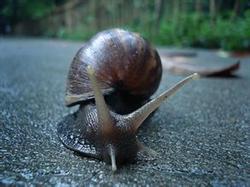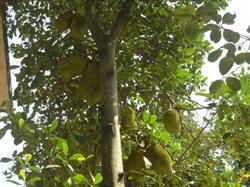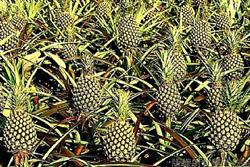Occurrence and Control of Stem Rot and Fruit Rot of Pineapple

1. Wooden pineapple stem rot the disease often causes a large number of fruit rot during fruit ripening and storage and transportation, with an incidence of 10%, 20%, and 30%, 40% in severe cases. Fruit damage often starts from the pedicle, the disease spot is a needle-like brown spot at first, and then gradually enlarges into a round, central dark brown, surrounding gray-brown water-stained large disease spot. Finally, most of the fruit turns brown and rotten, and the flesh is bitter and has no edible value. The disease part is dense with white sticky matter, which is the conidia of the pathogen. Wood pineapple stem rot is a fungal disease, its pathogen is Cocoa coccidiosporium, the conidia are colorless unicellular at first, then brown twin cells, the surface is longitudinally striated, oval to oval, wood pineapple stem rot pathogen is a kind of weak parasitic fungi. The pathogen overwintered on diseased branches and fruits with mycelium and conidia. In the next spring, when the climatic conditions were suitable, a large number of conidia grew as the source of primary infection to infect the young fruit of wood pineapple. Due to the strong disease resistance of the young fruit, the bacteria lurked in the fruit after invasion, and symptoms appeared one after another when the fruit began to mature and the disease resistance was low. In addition, germs also invade from the wound, fruit surface injuries caused by typhoons or insect pests during hanging fruit are all important ways for germs to invade. The key measure to prevent and cure this disease is to spray protection in the young fruit stage, especially after the wind and rain in Taiwan. The main agents are: 800 times solution of 70% methyl thiophanate wettable powder, 500 times solution of 40% copper oxychloride suspension, 800 times solution of 75% chlorothalonil wettable powder and 1% Bordeaux solution. Secondly, it is necessary to minimize fruit injury during production management and harvest, and it is best to use paper for single fruit packaging during storage and transportation, so as to avoid mutual contact with diseased fruits and increase infection. Second, wood pineapple fruit rot is a common disease, which mostly occurs in the period of fruit ripening and storage and transportation. Apart from anthracnose, the diseases causing wood pineapple fruit rot include wood pineapple soft rot, wood pineapple red powder and wood pineapple acid rot. 1. Soft rot of wood pineapple can damage inflorescence, young fruit and mature fruit, but mature fruit is the most susceptible. At first, the disease showed water stains, and soon expanded into brown soft rot, and the surface of the disease was covered with white coarse-haired sporangium peduncles and small black spots-sporangia. 2. Wood pineapple powdery mildew is often damaged together with stem rot and Rhizopus, resulting in brown rot of the fruit in the later stage. There is a layer of mildew on the surface of the disease, which is light pink after it is white at first. 3. The damaged part of the fruit becomes brown and soft, and there is a white mildew layer on the surface. The inside of the fruit quickly turns brown and soft rot, and there is juice flowing out, giving off a sour smell. The above three diseases are all caused by fungal infection. the pathogen of wood pineapple soft rot is Rhizopus creeping, whose mycelium is luxuriant and pseudoroots are well developed. The pathogenic fungus of wood pineapple powdery mildew is Monosporium roseum. The mycelium layer on the disease part is white at first, then pink, conidia colorless, twin-celled and oval. The pathogen of kuralic acid rot is Geotrichum albicans, and a large number of white molds are produced in the fruit disease part. the hyphae are broken into ascospores, colorless, oval after being rectangular at first, and obtusely round at both ends of the spores. The above three pathogens are all weak parasites, and their infection has two common characteristics: first, they only infect the growth stage of the host with weak disease resistance. Therefore, the three diseases are harmful to the mature fruit more, generally rarely to the green fruit, because the green fruit stage resistance is strong; second, generally can only invade the host from the wound or natural hole. Therefore, the occurrence of the disease is closely related to the injury on the surface of the fruit. During transportation, the diseased fruit can be contagious with each other. Therefore, in order to control the three kinds of fruit rot, we should pay attention to the prevention and control of fruit pests in the field, harvest carefully and avoid damage to the fruit during transportation. After the fruit is harvested, the fruit is soaked in 40% Tex glue suspension 500 Mel 800 times solution for 6 minutes, and then dried and packed with a single fruit of paper, which can prevent bacteria from contacting and spreading each other.
- Prev

Pineapple pest control
Pineapple is planted in humid and hot areas, and diseases and insect pests are sometimes quite serious, but there are not many researches and control methods at present. There are mainly longicorn, thorns, aphids, scarabs, blowing cotton scale insects and leaf spot disease, soot disease, flower soft rot, etc. To longicorn damage widespread and serious, harm branches, causing gum flow, branches withered, tree weakness, tree...
- Next

Conditions for creating pineapple orchards
During the growth and development of pineapple, the water solution of 300 times potassium dihydrogen phosphate was irrigated continuously for 8 times every 15 days, each time 1.5 × 2 kg per plant, through the trumpet mouth at the top of the pineapple plant. Let the aqueous solution of potassium dihydrogen phosphate flow along the leaf axil to the soil around the root. In this way, the pineapple plant growth is robust, the leaf is big.
Related
- Moge, come on! The staff of the peasant association in the producing area of cantaloupe were frightened when the crowd gathered.
- Causes and Solutions of low Fruit setting rate of Apple
- Symptoms and control measures of passion fruit virus disease
- Fruit growing lesson: how do apple orchards keep high yields?
- Can you build orchards in the mountains? What are the pros and cons?
- How to manage the coloring period of Crisson grape?
- This paper introduces the processing technology of two kinds of fig products.
- How much is a month for retired teachers in rural areas by 2020?
- How can strawberry planting increase sugar content? We should pay attention to management in many aspects.
- What are the cultivation techniques on how to improve the yield of golden fruit?

